N1 Flight #2
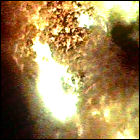 The Soviet Union’s second attempt to launch its moon rocket, the huge N1, ends disastrously. Again carrying an unmanned Zond spacecraft, the N1 barely clears the tower before stalling. Still full of highly flammable fuel, the N1 drops back to the ground, resulting in one of the most powerful man-made, non-nuclear explosions in history, completely wiping its launch tower and adjacent buildings off the map. (The Zond probe is lifted clear of the explosion by its escape rockets.) American spy satellites spot the damage to the nearby landscape from the explosion, tipping off the rest of the world to the N1 rocket program.
The Soviet Union’s second attempt to launch its moon rocket, the huge N1, ends disastrously. Again carrying an unmanned Zond spacecraft, the N1 barely clears the tower before stalling. Still full of highly flammable fuel, the N1 drops back to the ground, resulting in one of the most powerful man-made, non-nuclear explosions in history, completely wiping its launch tower and adjacent buildings off the map. (The Zond probe is lifted clear of the explosion by its escape rockets.) American spy satellites spot the damage to the nearby landscape from the explosion, tipping off the rest of the world to the N1 rocket program.

 Picked up by the BBC as a summer replacement for Doctor Who, which has just ended its sixth season with the departure of its entire cast, Star Trek begins its run on BBC1 with the episode
Picked up by the BBC as a summer replacement for Doctor Who, which has just ended its sixth season with the departure of its entire cast, Star Trek begins its run on BBC1 with the episode 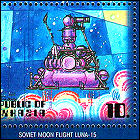 The Soviet Union launches unmanned space probe Luna 15 toward the moon, the Soviet space program’s last attempt to claim a victory in the race to the moon. Intended to land on the moon and gather a core sample of lunar soil which will then be rocketed back to Earth, hopefully ahead of the arrival of lunar soil samples from the concurrent American Apollo 11 moon landing attempt, Luna 15’s lander detaches and attempts its landing on July 20th…only to crash into the moon’s surface, losing all contact with Earth, while NASA astronauts Neil Armstrong and Buzz Aldrin prepare to depart with their soil samples intact. In a rare display of international cooperation, the Soviets shared basic orbital parameters of Luna 15’s flight with NASA to avoid any navigational hazards for Apollo 11.
The Soviet Union launches unmanned space probe Luna 15 toward the moon, the Soviet space program’s last attempt to claim a victory in the race to the moon. Intended to land on the moon and gather a core sample of lunar soil which will then be rocketed back to Earth, hopefully ahead of the arrival of lunar soil samples from the concurrent American Apollo 11 moon landing attempt, Luna 15’s lander detaches and attempts its landing on July 20th…only to crash into the moon’s surface, losing all contact with Earth, while NASA astronauts Neil Armstrong and Buzz Aldrin prepare to depart with their soil samples intact. In a rare display of international cooperation, the Soviets shared basic orbital parameters of Luna 15’s flight with NASA to avoid any navigational hazards for Apollo 11.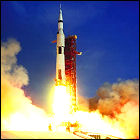 Apollo 11 lifts off, with astronauts Neil Armstrong, Buzz Aldrin and Michael Collins aboard. This is the first mission scheduled to attempt a landing on the moon, with Armstrong and Aldrin aboard the lunar module while Collins remains in orbit in the command/service module.
Apollo 11 lifts off, with astronauts Neil Armstrong, Buzz Aldrin and Michael Collins aboard. This is the first mission scheduled to attempt a landing on the moon, with Armstrong and Aldrin aboard the lunar module while Collins remains in orbit in the command/service module.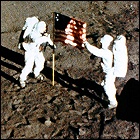 The Apollo 11 lunar module touches down in the Sea of Tranquility, a flat plain on the moon. Astronaut Neil Armstrong is the first human being to set foot on another body in the solar system, followed by “Buzz” Aldrin; the two spend roughly two and a half hours on the moon and gather nearly 50 pounds of samples of lunar soil and rock. This feat effectively ends the Cold War space race, though both the United States and the Soviet Union continue their lunar efforts: more Apollo missions are still on the schedule, and the Soviet continue trying to mount a successful launch of their giant N1 rocket.
The Apollo 11 lunar module touches down in the Sea of Tranquility, a flat plain on the moon. Astronaut Neil Armstrong is the first human being to set foot on another body in the solar system, followed by “Buzz” Aldrin; the two spend roughly two and a half hours on the moon and gather nearly 50 pounds of samples of lunar soil and rock. This feat effectively ends the Cold War space race, though both the United States and the Soviet Union continue their lunar efforts: more Apollo missions are still on the schedule, and the Soviet continue trying to mount a successful launch of their giant N1 rocket. Another round of tape-wiping eliminates more of the recorded history of Doctor Who at the BBC. The instructions to erase the final remaining Hartnell-era episodes go out, as well as an order to get rid of much of Patrick Troughton’s era. Where previous episode wiping sprees may have been sparked by a looming change of video standards, these latest erasures are more likely the result of BBC1’s impending switch from black & white to color after the successful launch of color broadcasting on BBC2 in 1967. The BBC deems non-news-related black & white material commercially unviable with the advent of color TV just around the corner – a decision that Doctor Who fans (and the BBC’s home video department) will regret years later. While many of the Hartnell episodes are recoverable from foreign markets at a later date, much of the Troughton era is lost forever – mere weeks after initial broadcast.
Another round of tape-wiping eliminates more of the recorded history of Doctor Who at the BBC. The instructions to erase the final remaining Hartnell-era episodes go out, as well as an order to get rid of much of Patrick Troughton’s era. Where previous episode wiping sprees may have been sparked by a looming change of video standards, these latest erasures are more likely the result of BBC1’s impending switch from black & white to color after the successful launch of color broadcasting on BBC2 in 1967. The BBC deems non-news-related black & white material commercially unviable with the advent of color TV just around the corner – a decision that Doctor Who fans (and the BBC’s home video department) will regret years later. While many of the Hartnell episodes are recoverable from foreign markets at a later date, much of the Troughton era is lost forever – mere weeks after initial broadcast.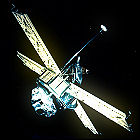 Just two days before its sister ship Mariner 6 makes its closest flyby of Mars, NASA/JPL’s unmanned space explorer Mariner 7 loses all contact with Earth. Ground controllers race to find a solution, re-establishing communications via Mariner 7’s low-gain antenna, which can only return data at a reduced speed and bandwidth. Its high-gain antenna resumes normal operation shortly after Mariner 6’s closest pass by Mars, allowing Mariner 7 to complete its mission as planned.
Just two days before its sister ship Mariner 6 makes its closest flyby of Mars, NASA/JPL’s unmanned space explorer Mariner 7 loses all contact with Earth. Ground controllers race to find a solution, re-establishing communications via Mariner 7’s low-gain antenna, which can only return data at a reduced speed and bandwidth. Its high-gain antenna resumes normal operation shortly after Mariner 6’s closest pass by Mars, allowing Mariner 7 to complete its mission as planned.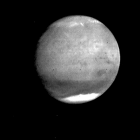 The unmanned NASA/JPL space probe Mariner 6 makes its closest flyby of planet Mars, coming as close as just over 2100 miles from the Martian surface. While measuring the composition of the Martian atmosphere and trying to analyze its surface from space, Mariner 6 passes over densely cratered terrain, not spotting the huge canyons and volcanoes that will later become synonymous with Mars. Mariner 6’s identical twin, Mariner 7, is just days behind it, and ground controllers rewrite Mariner 7’s flight plan to get closer looks at surface features first spotted by Mariner 6.
The unmanned NASA/JPL space probe Mariner 6 makes its closest flyby of planet Mars, coming as close as just over 2100 miles from the Martian surface. While measuring the composition of the Martian atmosphere and trying to analyze its surface from space, Mariner 6 passes over densely cratered terrain, not spotting the huge canyons and volcanoes that will later become synonymous with Mars. Mariner 6’s identical twin, Mariner 7, is just days behind it, and ground controllers rewrite Mariner 7’s flight plan to get closer looks at surface features first spotted by Mariner 6.